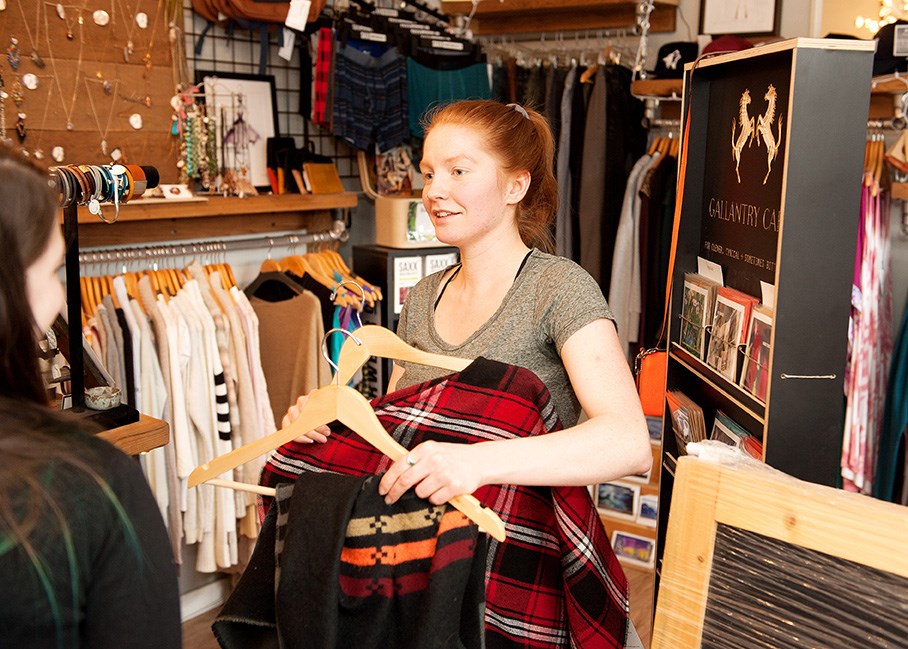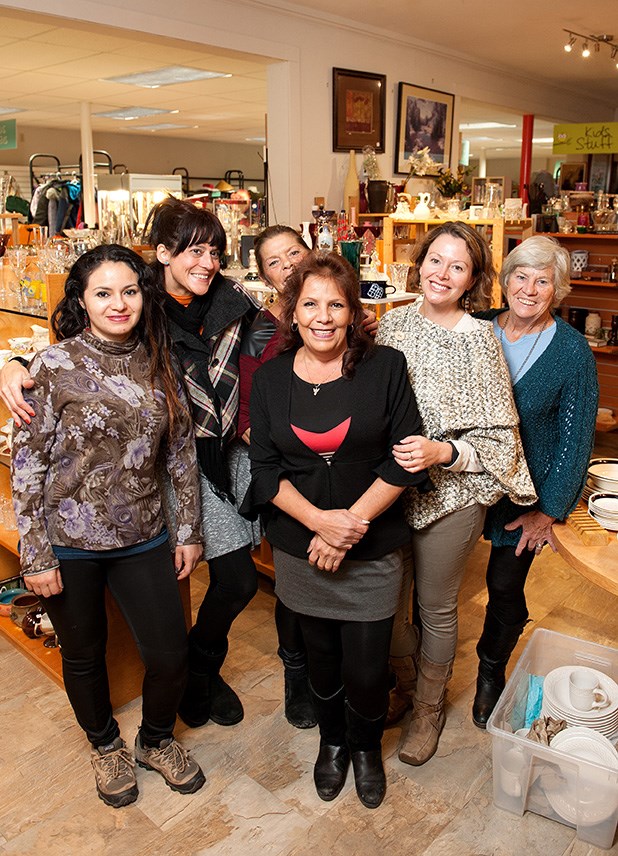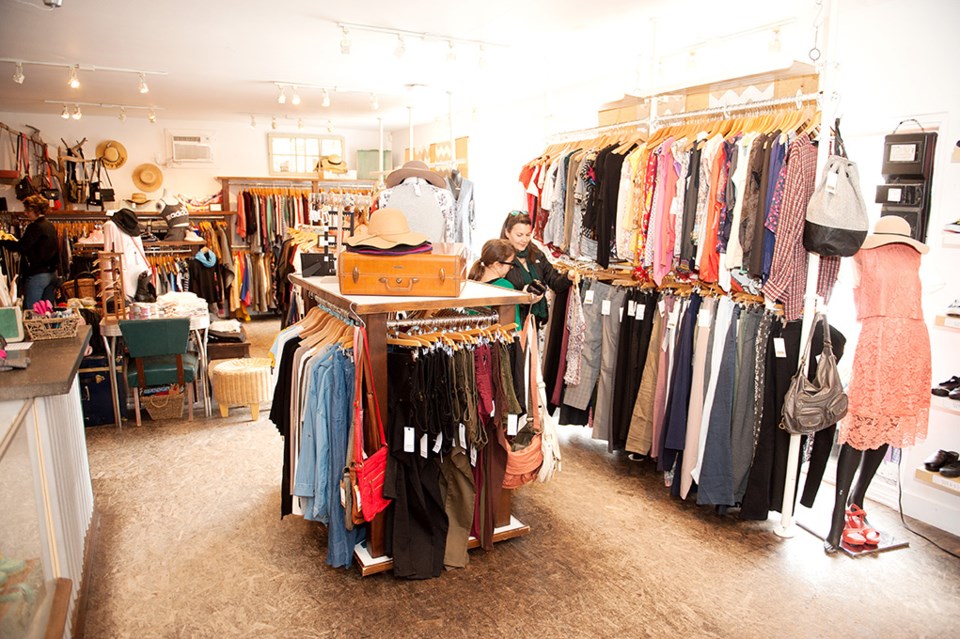A black scarf tied around Gillian Callard’s neck decorated with small shells and her animal-print top are part of this septuagenarian’s self-described “out-there, esoteric” style.
Like most of the clothing in her closet, she bought her outfit at a thrift store in Downtown Squamish where she volunteers.
While the “energy” of an item of clothing is what draws her to it, it’s not the main reason she buys her clothing second-hand.
“I think the world has got itself into a particularly sordid state with the hyper-consumerism,” Gillian says. “I think it’s really important for our community, for years to come, for these young children, to have a clean environment in which to be brought up. Ecology means a lot to me, much more to me than the dollars [saved].”
From an affinity for shabby-chic to wanting to save money or protect the environment, there are many reasons Squamites are buying into the second-hand economy.
And in Squamish, there are plenty of places to shop: there’s the Random Clothing Gallery and Pearl’s Value and Vintage on Cleveland Avenue, Treasure Boutique on Mamquam Road, all which sell second-hand goods.

“There was a stigma many years ago where people almost didn’t want to be seen in a second-hand store, and there are still probably people who wouldn’t step foot in Pearl’s,” says Kate Harvey, manager of Pearl’s Value and Vintage Store.
“But it’s become so different now; people are more than happy to come in and purchase second-hand or pre-loved, or whatever they want to call it. They’re happy to save money, they’re also happy with the environmental impact as well.”
Harvey has been the store manager since 2011. Women’s clothing has always been a big seller, and baby clothes and toys, and housewares are also popular.
But over the last few years, both donations and sales have been growing.

“What I consider the big game changer was Sea to Sky Gondola coming to Squamish,” she said. “That when we really started to see a big increase in foot traffic.”
Whether it’s from an increase in tourism, the changing demographic of Squamish, or a bit of both, more people are buying used. Seniors downsizing, sometimes donating an entire household of goods, is something Harvey says she’s seen a lot of in recent years. New landlords looking to furnish a new suite or AirBnB rental is another reason that brings people to her store.
“So many people come in and actually show us before and after photos being able to do their entire place from Pearl’s,” she says. “They’ll come in buy all the linens, lamps, pictures for the walls, all the dishes, cutlery, towels; basically everything they can possibly do.”
Buying from her store, and re-selling online through Kijiji, Craigslist or Facebook’s marketplace is also common, but that doesn’t seem to bother her.
“I think there’s enough to go around.”
She may just be right.
Debby Forsyth, who goes by Dee Hildebrand on Facebook, runs three buy-and-sell groups on Facebook, including My Squamish Buy and Sell with over 3,000 members.
“You can get second-hand pretty much anything you want in Squamish,” she says. “Either somebody will have a post for it and you buy it if that you’re interested in it, or you put you’re “in search of” (ISO) and somebody will respond to it.”
Late 2016, and into 2017, Forsyth says she saw a boost in people using her groups.
“With the influx of new people coming in, there are a lot of people looking for new stuff,” she said. “That’s how I know there’s a lot of new people here: A lot of people who are joining these groups write: ‘I’m moving to Squamish.”
Whether a boom in second-hand sales on Facebook indicate a population shift or just an increase in online selling behaviour is unclear: Facebook also launched their Marketplace in October 2016.

And buying into the second-hand economy isn’t isolated to Squamish, it’s part of a growing trend across Canada.
According to Kijiji’s recently released Second-Hand Economy Index for 2018, 85 per cent of Canadians are involved in the second-hand economy.
Last year, $4.1 billion were spent on second-hand goods in British Columbia. Clothing, shoes and accessories top the most popular goods exchanged in the country, followed by entertainment items including DVDs and books, baby clothing and accessories, and furniture.
Lindsay Tedds studies underground economies and teaches at the University of Victoria. She also helped create the Kijiji’s second-hand economy study in 2016.
How this economy interacts with the general economy is one area she investigated.
“There is some crowd-out, but what we find actually is the second-hand economy is a vehicle for individuals to obtain goods that they can’t or won’t buy in the observed economy,” she says.
“(Sometimes) my maximum willingness to pay is far below the price of a new good, so I’m not going to buy it new, and if it wasn’t available used I wouldn’t buy it.”
Apart from price, Tedds says environmentalism seems to be the main reason people are buying used.
“There’s also things you can purchase in the second-hand economy that you can’t purchase in the new economy,” she says.
Like a vintage Vespa, for example.
While Colin Bates usually shops for musical instruments, like guitars and amplifiers, he also uses Squamish Facebook groups to find the vintage scooters he restores as a hobby.
“If someone has something like that to sell, that’s where they would post it,” he says. “You wouldn’t be able to go to a car lot and find a vintage Italian scooter.”
Bates is also a beekeeper, and listed honey from his backyard hives for sale in a Facebook group, rather than setting up a booth at a farmer’s market or sitting out on his front lawn with a sign.
“It seems to me that in this day and age, the online buy and sell is sort of the de facto way to spread the word about something you’re interested in selling.”
With a population of just under 20,000 set to double in the next 15 to 20 years, Squamish residents can expect the second-hand economy to grow. Much of that will be online.
And for those Squamish residents who may feel anxious meeting strangers online, the Squamish RCMP recommend people meet in front of the detachment to make transactions safer.



